| Columns Retired Columns & Blogs |
So the P3 with the tt-psu puts it right in the same price range as the vpi scout jr. Do you think one of them is better than the other?
I began with Dr. Feickert Analogue's PlatterSpeed app. For some reason, I assumed that Rega had solved the whole "Regas run fast" thing. They haven't. Powered by Rega's standard wall wart, the Planar 3 played the Feickert app's 3150Hz test tone at 3159.8Hz (see figs.1 and 2). Definitely fast. Rega's optional TT-PSU power supply ($395) slightly improved that figure, to 3158.2Hz. For comparison, Technics' SL-1200GAE played the 3150Hz tone at 3150.2Hz.
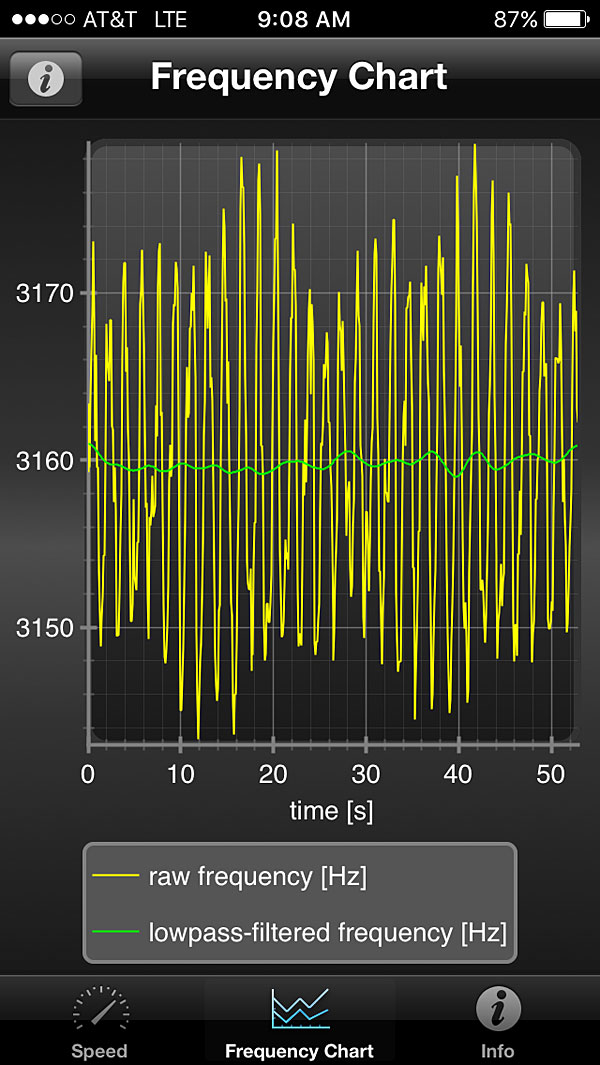
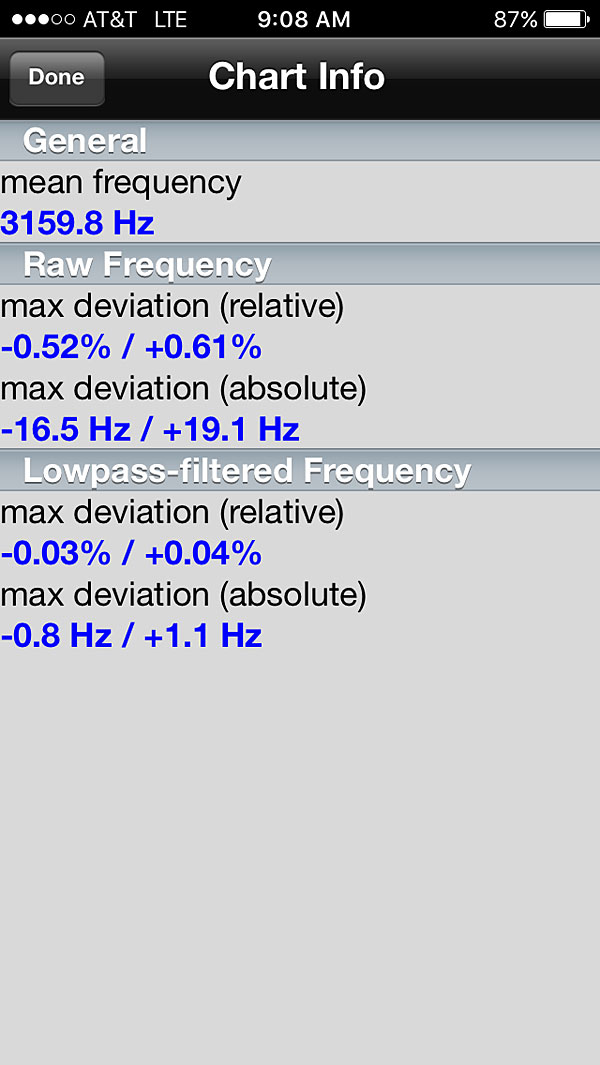
Most important, the Rega's platter speed was exceptionally smooth and consistent with both AC sources. I heard only a small improvement with the optional supply, but I appreciated the TT-PSU's knack for lower motor noise, and the convenience of changing speeds by pushing a button instead of removing the platter and moving the drive belt to a different groove on the pulley. I used the TT-PSU for 90% of my listening.
Except for the use of spacers or shims, Rega's tonearms lack any way of adjusting a cartridge's vertical tracking angle (VTA), stylus rake angle (SRA), or azimuth. Therefore, I couldn't wait to try Musical Surroundings' Fozgometer azimuth tester, which works by measuring crosstalk form one channel to the other. This test can't tell whether an imbalance is caused by imperfect headshell azimuth or an imperfectly made cartridge; that said, the Elys 2, factory-installed in the RB330, was pretty darn good.
Then it got interesting. I'm puzzled by reviewers who test turntables by scratching the tonearm, or tapping the plinth with the volume turned up. Such tests seem too far removed from the realm of normal, everyday music listening to be relevant. Nevertheless, I was curious about the possible side effects of Rega's strategy of connecting the platter bearing, the tonearm mount, and the motor directly to a light, rigid plinth. So I tried my own little test. In the spirit of quasi-science, and with the platter spinning at 331/3rpm and the Planar 3's stock wall-wart supply, I listened to the plinth and the RB330 bearing housing with a stethoscope.
The sound of the vibrating motor was shockingly loud. When I listened again, this time with the TT-PSU supply, the apparent frequency of the noise had dropped by a couple of octaves, and by about 50% (–6dB) in volume.
Then, with the phono stage turned off and the Rega playing an LP of Gregorian chant, I held the stethoscope to the plinth. I could make out the words the choir was singing. I couldn't believe it.
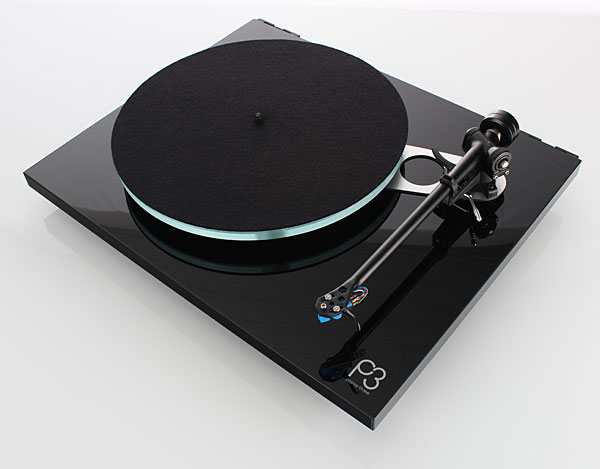
I performed these same tests on a VPI Scout Jr. ($1599), which was, even with its completely detached motor, only about 50% quieter than the Rega. (Obviously, my equipment rack was transmitting motor vibrations.) When I moved the Scout Jr. to PS Audio's combination isolation base/power conditioner ($999; review in the works), the noise went down another 50% (–6dB total). The PS Audio Power Base was less helpful with the Rega, but it made recordings, especially of opera, noticeably quieter and more transparent.
I tried the stethoscope-on-plinth test on the Roksan Radius 7 turntable ($2500): It was approximately 94% dead silent. The Palmer 2.5 ($9300) was 98% silent. And when I put my 'scope on the armboard of my Linn Sondek LP12 Valhalla, it was the quietest of all. Who would have guessed? You know the audiophile expression ink-black backgrounds? The Palmer 2.5 is totally high-end: It produces ink-black background spaces and w i d e dynamic expression. In other words, music emerges from an extremely low noise floor. Meanwhile, the Roksan Radius 7 makes incredibly textured and three-dimensional images that emerge from a substantial, almost-"black" space. I imagine a correlation between these desirable sonic effects and what I heard through my stethoscope.
I believe the stethoscope test is musically relevant because, unlike tapping a plinth or scratching a tonearm—which are calamitous and externally caused—the distortion the 'scope reveals is constant and insidious in nature. Just as we can hear harmonic distortion in amplifiers or jitter in digital systems, I feel certain that any noise produced by the motor and transmitted to and by the plinth must contribute to any turntable's basic sound character. How much? Only a little—I think. But maybe a big little.
The new Planar 3 played Music with a capital M. It rocked, it swung, it slipped and slid. It delivered human-scaled musical art. It played solo piano with stupendous rigor, weight, and expression. However . . .
I suspect that the noise of the Planar 3's motor, coupled with that sing-along plinth echo, contributed not only to the slight punchy opacity I perceived, but also, maybe, to my perception and enjoyment of musical flow. I wonder: if the Rega's bearing, plinth, and tonearm are literally "playing along" with the music, could they not also be microscopically doubling the notes, hitting the beats extra hard, and reiterating the music's rhythms a little more than those of other turntables? I think these subtle noise effects I've uncovered might be emphasizing rhythms and encouraging us to tap our feet, nod our heads, and groove along. I think they might actually be good things (footnote 2).
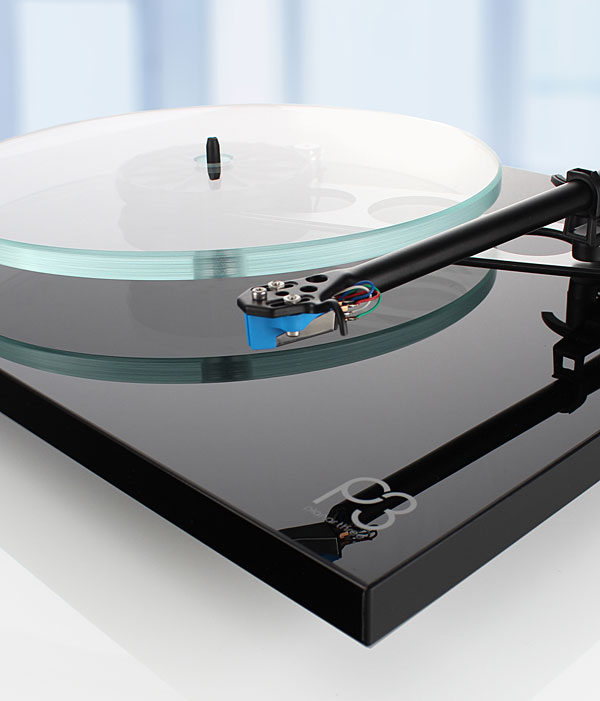
Perhaps these subtle, nearly subliminal mechanical emphases project the music's timing and pace more pointedly into the listener's consciousness. I imagine it's like doubling a singer's voice or emphasizing a kick-drum track. I wonder if this very subtle form of reverb might be the secret sauce, the true source of Rega turntables' reputation for pacey, boogie-oriented sound.
The Rega RB330 tonearm
When I raise a tonearm by its finger lift, I can feel its weight and rigidity. I can feel, very precisely, how stiff and stable it is. I can feel if it's a one-piece casting, like the Rega RB330 ($595), or a thin, hollow, bubble-tea straw with a glued-on headshell and bearing yoke, like the Roksan Nima. As I lift the arm from its rest, I can feel all the way down the armtube, right through to the bearings. This is not subtle. If you try it, you'll feel all this too.
Observing how incredibly different each tonearm feels from all other models can be radically enlightening. Try imagining the feather-light aluminum armtube of the Roksan Nima; the thick, damped stainless-steel tube of the SME M2-9; the extruded, rectangular-section, solid aluminum of the Abis 1.2; the silky-smooth, bead-blasted finesse of Audio Origami's aluminum-alloy PU-7; and, especially, the almost startling rigidity of Rega's new one-piece RB330. (See what I mean?)
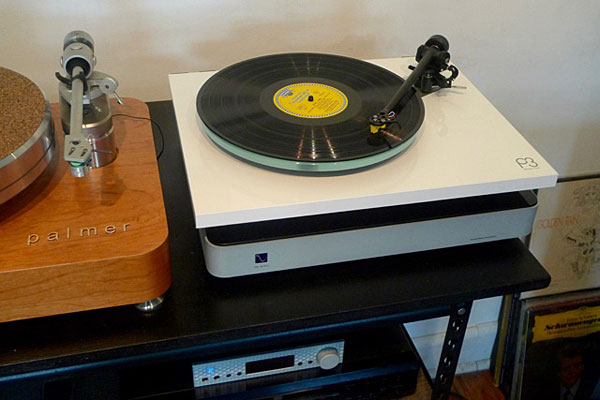
With gimbal-bearing arms, we can feel the tightness or looseness, the texture of their movements, and the relative amounts of friction.
When I move any tonearm, I can sense the weight of the attached cartridge. I can sense the position of the rotating bearing axis, the mass of the counterweight, and the force of the antiskating bias. Not only can I feel all this—I imagine I can hear all this mechanicalness going on as a record is being played. The RB330 impressed me greatly with its low-texture, nearly frictionless precision. The best arm I've ever groped was a Breuer Dynamic (discontinued): I'll never forget how airy-smooth yet perfectly true and precise that Swiss arm felt. I'll never forget how invisible it sounded. The inexpensive Rega RB330, made in the UK, comes ridiculously close to my memory of the Breuer's perfectly tight, perfectly loose invisibility—so close that I believe the high quality of Rega arms is the No.1 reason their record players continue to make so many people happy.
Big white belt
Now how can this be? I didn't touch the volume knob when I swapped out the Rega Planar 3's stock black drive belt for the optional, thicker white belt ($59.99), but the volume seemed to increase. Every instrument on Danses Anciennes de Hongrie et de Transylvanie was instantly bigger, more tangible, more focused, more textural. Suddenly, I noticed the inside volume of the drums! But using a thicker belt makes the turntable run a bit faster: the very slightly increased distance between the thicker belt's centerline and the axis of the drive pulley very slightly changes the drive system's "gear ratio."
Using Dr. Feickert's PlatterSpeed app, I measured the change in speed: from 3159.8 to 3171.3Hz (figs. 3 and 4). Realistically, this is an increase in speed of less than 1%. However, I feel certain that this minute change is audible, and equally certain that Roy Gandy and Rega have built their reputation of making pace-rhythm-and-timing machines on just this sort of engineering subtlety. I love the white belt and the way it makes my music feel. If you buy a Planar 3, don't think—just buy the white belt and TT-PSU power-supply options. Both make recordings more enjoyable.
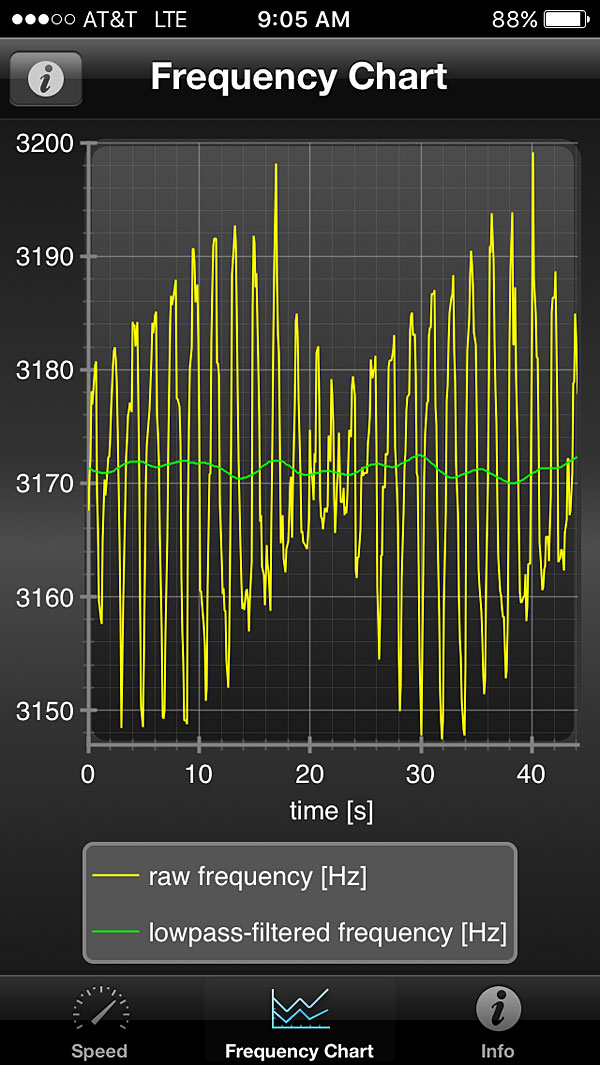
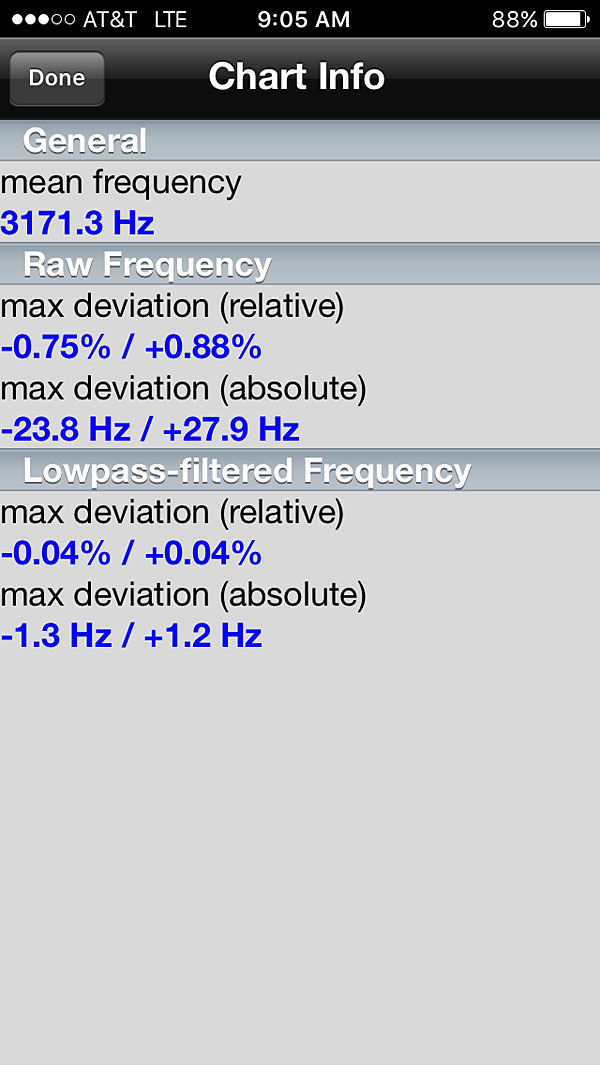
And you know what?
I love the way Rega Research's new Planar 3 navigates my black discs. I love the way it honors musicians. I love the way each of the Rega's engineering subtleties—in the tonearm, the float-glass platter, the light and rigid plinth, the nonadjustable tonearm, the motor and power supply, and the thicker white drive belt—combine to make listening to black discs enjoyable in a way that's more psychic and emotional than audiophile-sonic. For me, the best record-playing system is the one that most vigorously directs my attention toward the humans behind the music—not the sound of my hi-fi. Rega's new Planar 3 is exceptional at doing just that.

So the P3 with the tt-psu puts it right in the same price range as the vpi scout jr. Do you think one of them is better than the other?

I reviewed the Scout Jr. also. Both are fine musical-loving turntables - but extremely different in how they are engineered and how they make recordings sound. The VPI is surely a bit quieter and the Rega is surely a bit more "fun" . . . the Rega tonearm might "like" more cartridges than the VPI - but then, maybe not. I cannot really apply the word "better" in this comparison. Everything in audio plays differently and your personal taste really is all that matters.

With the tt-psu and exact cartridge the PLANAR 3 costs about the same as a Rega RP6. Which turntable sounds better? GROOVETRACER and other companies make tweaks for Rega tables.Groovetrace makes platters and subplatters for Rega tables. Do these tweaks improve the sound? This would make a good followup.

Hi, Herb. I enjoyed your review of the new Planar 3, and if I buy one, I will definitely consider the Exact instead of the Elys.
You state that the Exact attaches to the headshell with three screws. Doesn't the Elys attach the same way?
Thanks,
Jay F

No question that if there is one upgrade worth every nickle associated with these Rega tables, the Exact cartridge is worth it. Always a debate if the change in sound is too subtle for the average consumer to hear. This is one where I think in a double blind test the average consumer could tell the difference probably 95% of the time. It is a radical difference. The sound is more full, refined and open, even with a budget phono stage like the Vincent Pho 8 or the onboard phone stage foe the Brio R. I own tables with both and there is no comparison between the two.

I initially used the phono stage in my Brio R with my P3 and thought it was great. That was until I tried a stand alone unit (Project Tube Box S) which really opened my eyes! I tried it for the tubiness, which made less difference than I thought, but the real difference was the clarity and detail of the image.

http://www.talkelectronics.com/turntables/edwards-audio-tt3-turntable/
This is a rega-based turntable, may be a good candidate for a review, and to make use of your stethoscope, since the motor is isolated in a subchassis, you could see if there is difference in background noise.

Thanks for much for this review and your comments about the Elys 2. Having recently upgraded to a P3/Elys 2 from a P2/Carbon, whilst there's more authority in the sound and it's nicely presented, I'm missing a liveliness, openness and sparkle, especially noticeable in female vocals, that I had in the previous setup. I might not stretch to an Exact, but think it's time to look at a different cartridge. Thanks again, I thought there was something wrong with my ears until I read this!

I've had mine for a few months now, having bought it after reading this review. Here are my two cents:
Increased isolation via some form of base does make an audible difference, as noted here. In keeping with the humble, no nonsense nature of this product, I made my own isolation platform consisting of a bamboo base (overturned Ikea Aptitlig chopping board) resting on 4 halved squash balls. The board is the perfect size, comprises bamboo layers with alternating grain direction and is stiff and reasonably attractive. The changes manifested as a tightening of base and slight warming of the sound.
As noted here and elsewhere, Rega arms are designed with stiffness in mind rather than adjustability. I experimented with VTA fine tuning via split shims that can be installed without removing the arm. Thus far, raising the arm base to what is considered to be a classical alignment has only degraded the sound rather than improved it. Perhaps this confirms the Rega house view that stiffness trumps adjustability? I also note that the torque to which the arm mount screws are tightened is much more sensitive than I could ever have guessed. Over tight results in a deadening of the music so I have settled on nipping-up the screws just past where they grip.
One final observation that I have not seen commented on elsewhere is that in my system at least, using the dust cover whilst listening does not change the sound.
My set up: Sure M97XE, Rega P3, Project Tube Box S, Van Den Hul CS-122 speaker cables and interconnectors, Dynaudio Focus 160 bookshelf speakers.

I own a modified RP1 (platter, subplatter, bearing, belt, tonearm wiring replacement, etc.), however I do not like the Rega carts. I feel that Ortofon and Audio Technica can beat the sound at the same price. That said, I have an issue with the acrylic platter that isn't indented for records to be played on the acrylic. Why have an acrylic platter where you can use the capability of the material. It needs a proper acrylic platter that is turned properly with the indent cut. (19mm platter for $116 shipped from England). As much as I love Rega turntables, they irritate me regularly by going cheap where they shouldn't.

I replaced a Pro-ject Debut Carbon DC with the latest Rega Planar 3.
The Debut is much over-rated. It sounds pretty good but is cheaply made.
I used the Rega with a Sumiko Pearl, then a Denon-110 and now a Grado Reference Platinum 2.
The Sumiko is very nice for a cheap cartridge. Denon is a big step up but a bit harsh. Grado is a revelation. It has all the dynamics of the Denon but is not harsh. Bass slam is fantastic and very clear smooth mid-range. This combination is fantastic, Rega is all you will need. The Grado does hum a bit with the Rega, but it does not bother me. the overall fantastic sound is worth it. But be aware of that, it may bother you. I have owned many turntables and cartridges including Thorens TD160 and high end Ortofon MC, but the Rega/ Grado beats them all. I am using HD650 headphones and NAD C 350 amp with Pro-ject phono box.